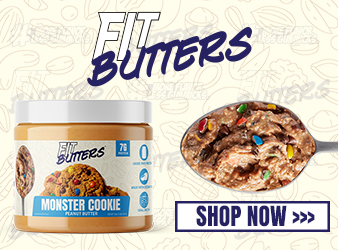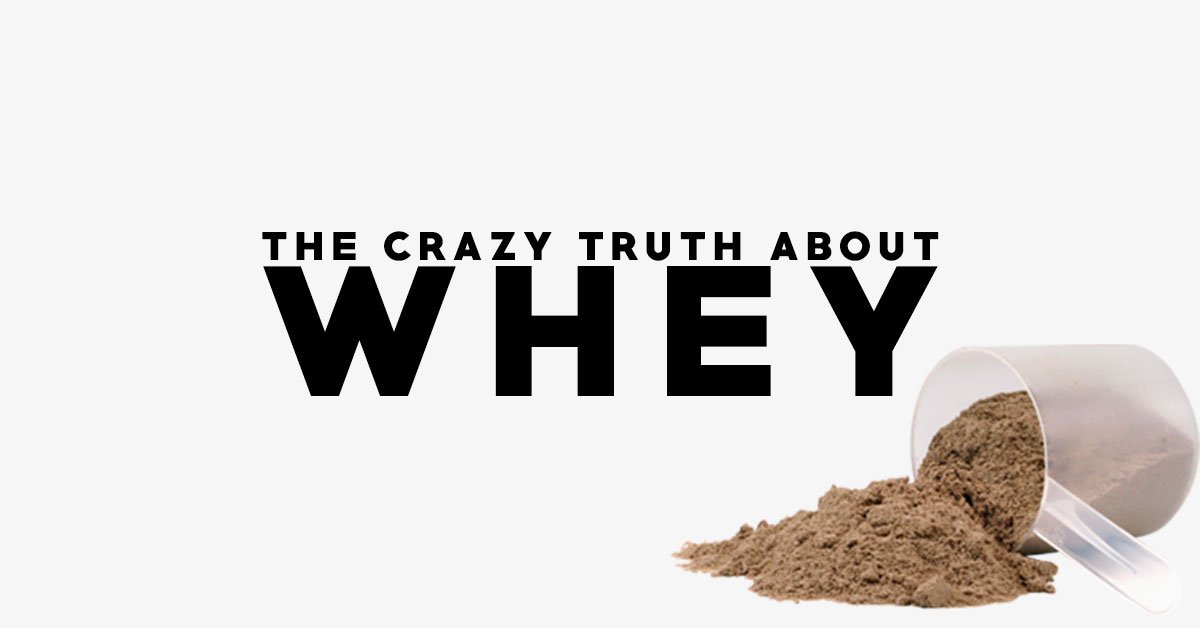
Not all whey protein is created equal. There are three basic types of whey proteins found in today's sports nutrition products: whey protein hydrolysate, whey protein isolate and whey protein concentrate. Within each of these variations of whey protein, the quality can vary; however, the quality varies the most in whey protein concentrates (WPC). This is where supplement brands can get you.
The vast majority of supplement companies are listing their ingredients correctly. They are only required to state the actual ingredient used, not the quality of protein source. If you buy a tub whey protein concentrate, all that company has to do in the ingredients section is properly list whey protein concentrate in the correct order; this is generally the first ingredient listed, but it doesn't mean it is a high quality whey protein concentrate.
Fortunately, there is a new wave of labeling practices that are consumer-first that several brands like NutraBio and GHOST have embraced. These brands are not only listing the type of protein used, but the quality of protein and the actual yield of protein (more on this later).
Before we dive into the consumer-first labeling techniques, it is important to understand the difference between the three common types of whey proteins. After we establish that, we will take a deeper dive into the world of whey protein, specifically whey protein concentrate so you can better understand what is actually going on in the world of whey protein. All three variations of whey protein are slightly different, but they are derived from the same source and the amino acid profile of the protein content is similar (unless there is amino spiking involved).
Thrive Leads Shortcode could not be rendered, please check it in Thrive Leads Section!
Whey Protein Hydrolysate
Whey protein hydrolysate is touted as the "best" protein source as it is the fasted digestible protein. It is considered to be "predigested" meaning that it would actually digest and absorb quicker than even whey protein isolate. Whey protein hydrolysate digests quicker than whey protein isolate and whey protein concentrate because it has already undergone partial hydrolysis - a process necessary for the body to absorb protein.
In terms of protein quality, there is no evidence that whey protein hydrolysate is any better than whey protein isolate. The quality of whey protein hydrolysate also depends on hydrolization (average level of hydrolization is 3% in the industry - some brands are higher which does make a positive difference). In fact, some versions of whey protein isolate can actually be higher quality than whey protein hydrolysate. The advantage is the time to digest versus the others.
Whey Protein Isolate
Whey protein isolate is a popular protein source used by brands as it is a cleaner form of protein versus whey protein concentrate. A typical whey protein isolate can range from 90%-97% protein quality (with added moisture this can actually dip to 87% on cross-flow with ion exchange is bit higher, but we won't worry about that here). A whey protein isolate goes through additional processing to remove fats and carbs versus a whey protein concentrate. This does not necessarily mean it is a superior protein to whey protein concentrate.
A whey protein isolate has a couple benefits over a whey protein concentrate. First, a whey protein isolate can range from 90%-97% quality versus a whey protein concentrate which is a max of 80%. Second, if you are someone that is lactose intolerant, a whey protein isolate is a safer selection than whey protein concentrate because most, if not all, the lactose has been removed. Third, a whey protein isolate, without any additives (digestive enzymes or something like Velositol) will absorb slightly quicker than a whey protein concentrate.
When whey protein isolate is listed on an ingredient panel, you can safely assume that the quality is at least 90%. A whey protein isolate is typically going to cost more to the consumer versus a whey protein concentrate due to the additional processing it undergoes to remove fats and carbs with a higher percentage of protein.
Whey Protein Concentrate
Whey protein concentrate is the most popular form of whey protein consumed today. It's with whey protein concentrate that much of the deception can occur. Whey protein concentrate can technically range from 25% to 89.99% protein quality. That is a huge difference between the two. The two most common forms of whey protein concentrate are WPC34 (34% protein quality) and WPC80 (80% protein quality). Let's focus on those two for the duration of this article.
Let's take a look at what makes up each version of the WPC34 and WPC80 protein:
Typical Composition | WPC34 | WPC80 |
|---|---|---|
Protein | 34%-36% | 80%-82% |
Lactose | 48%-52% | 4%-8% |
Fat | 3%-4.5% | 4%-8% |
Ash | 6.5%-8% | 3%-4% |
Moisture | 3%-4.5% | 3.5%-4.5% |
Using the table above as reference, if you had 25g protein listed on the label, here's what that 25g would be made up of:
WPC34
Protein: 8.5g
Fat: 1g
Lactose: 12.5G
WPC80
Protein: 20g
Fat: 1.5g
Lactose: 1.5g
You are actually yielding only 34% of the 25g as complete protein with WPC34 versus 80% of the 25g on WPC80. WPC34 would yield only 8.5g of complete protein versus 20g of complete protein for a WPC80. This means you would need 59g of WPC34 to equal the same amount of complete protein yielded from only 25g of WPC80.
You might be thinking that you can just take more of the cheap WPC34 protein to get the same amount of complete protein in WPC80. Sure, you could, but you may not like the way you feel from doing that since you are ingesting a bunch of unwanted and unneeded lactose.
If you've ever felt bloating, discomfort or suffered from diarrhea from protein (or a weight gainer) it could be from the lactose in a cheap protein source like WPC34. Adult humans were not setup to digest lactose at large amounts past childhood. Our bodies make less lactase as we age (enzyme responsible for breaking down lactose) thus making approximately 75% of the worlds population lactose intolerant.
Protein powders may not be the biggest offenders of using WPC34. Weight gainers (mass gainers) are notorious for using WPC34 as it is cheap and adds a bunch of calories. Most weight gainers are "dirty" and not clean. Keep this in mind next time you buy a mass gainer.
Now that you have all this background information, let's look at a real-life example of a WPC80 below on NutraBio Classic Whey:

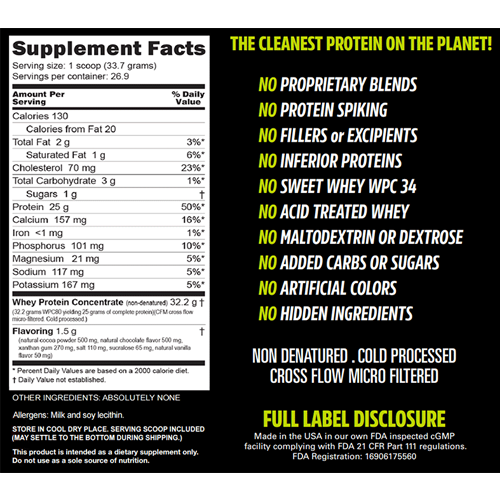
Use coupon code INFORMANT to save 10%
NOTE: The quality percentage number is NOT calculated by taking the grams of protein divided by serving size. That is only the percentage of protein per serving...not the actual percentage of protein quality.
The example listed above is from NutraBio Classic Whey Protein. The label reads 25g of total protein with a serving size of 33.7g. That means that there is 74.2% protein per serving. However, the quality of protein used to make up the 25g of total protein is a whey protein concentrate 80% (WPC80). This is the highest quality of whey protein concentrate. NutraBio takes it a step further on their label to list out the TOTAL protein and the TOTAL protein amount yielded.
In this case, NutraBio lists out the grams of protein of WPC80, and also gives us the amount of protein that is yielded from that amount. This label states that out of 32.2g of TOTAL non-denatured WPC, it is yielding 25g of COMPLETE PROTEIN. Now, if you take 32.2 and multiply that by 80% you will get 25.76g complete protein. This is higher than the listed amount on the label for two reasons:
- Whey is a natural product, the protein ratio can vary batch-to-batch (also taking into account moisture), so NutraBio takes the lowest end of their spec to ensure they meet label claims 100% of the time (this means you might actually be getting more than 25g of complete protein per serving but NEVER under)
- FDA requirements on labeling requires brands to round down to the nearest gram or 1/2 gram (you can never legally round up)
Use coupon code INFORMANT to save 5%
Let's look at another real-life example using WPI, WPC80 and Whey Protein Hydrolysate on GHOST Whey:
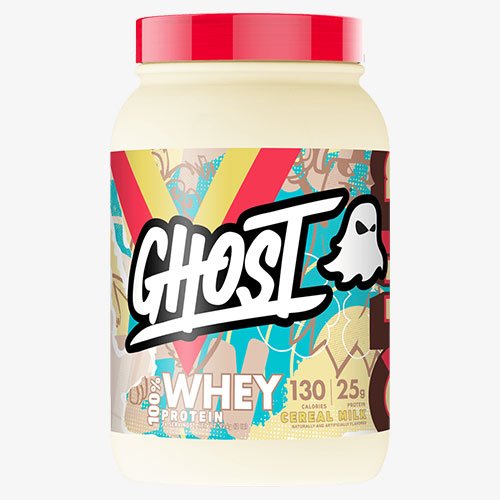
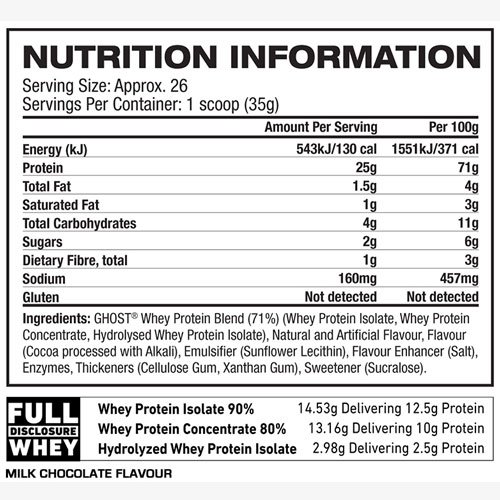
Use coupon code INFORMANT to save 20%
NOTE: The quality percentage number is NOT calculated by taking the grams of protein divided by serving size. That is only the percentage of protein per serving...not the actual percentage of protein quality.
This example is from GHOST. This is their GHOST Whey. GHOST Whey uses the three variations of whey protein we discussed in this article. The label states 25g protein making up 71% of the total serving (25g/36g=71%). This is not a reflection of protein quality. We know this because GHOST discloses that they use whey protein isolate 90%, whey protein concentrate 80% and hydrolyzed whey protein isolate (at least 90%). The three of these protein qualities is above 80% so the 71% only indicates how much of the serving size is protein versus flavoring, enzymes, etc.
If you take the WPI90 amount of 14.53g and multiply it by 90% you will get 13.077. When you take 13.16g of WPC80 and multiply by 80% you get 10.48g. Lastly, when you take 2.98g of hydrolyzed whey protein isolate and multiply by 90% (typical WPI quality) you get 2.682g. Similarly with NutraBio, these amounts are higher that what is listed on the label due to two main reasons:
- GHOST adds overages to everything to account for efficiency over the lifespan of the product; they try to account for as many variables as possible to ensure they always meet or exceed label claims if they were tested. Recent testing came in at 101% of label claims. (this means you can actually be getting more than 25g protein per serving but you will never get under that)
- FDA requirements on labeling requires brands to round down to the nearest gram or 1/2 gram (you can never legally round up)
Use coupon code INFORMANT to save 20%
Final Takeaway
The amount of protein listed on your label divided by the total serving amount does NOT equal the protein quality. In order to know the quality of protein used, the company must disclose this information on the ingredient panel or, as a consumer, you can reach out to your favorite brand and ask them to provide documentation on their quality of protein.
Unlike pre-workouts where a company will withhold from disclosing dosing on proprietary blends, there is no reason for a company to not disclose their protein quality unless they are using a cheap protein source (with that said, there really is no reason to use a proprietary blend either since companies can reverse engineer through testing).Final Takeaway
If your brand does not currently list out their quality of protein sources, demand that they do so. You deserve the right to know. If they are using WPC80, they should acknowledge that and be proud to showcase that (this may require education as some consumers could be confused, but this is a battle we face daily and are trying to change). If your brand of choice refuses to put it on the label, or elects to not share that information with you, I would suggest looking at a company like GHOST or NutraBio who does provide that info. You work hard for your money, your supplements (especially your protein powder) should work hard for you.
Thrive Leads Shortcode could not be rendered, please check it in Thrive Leads Section!




